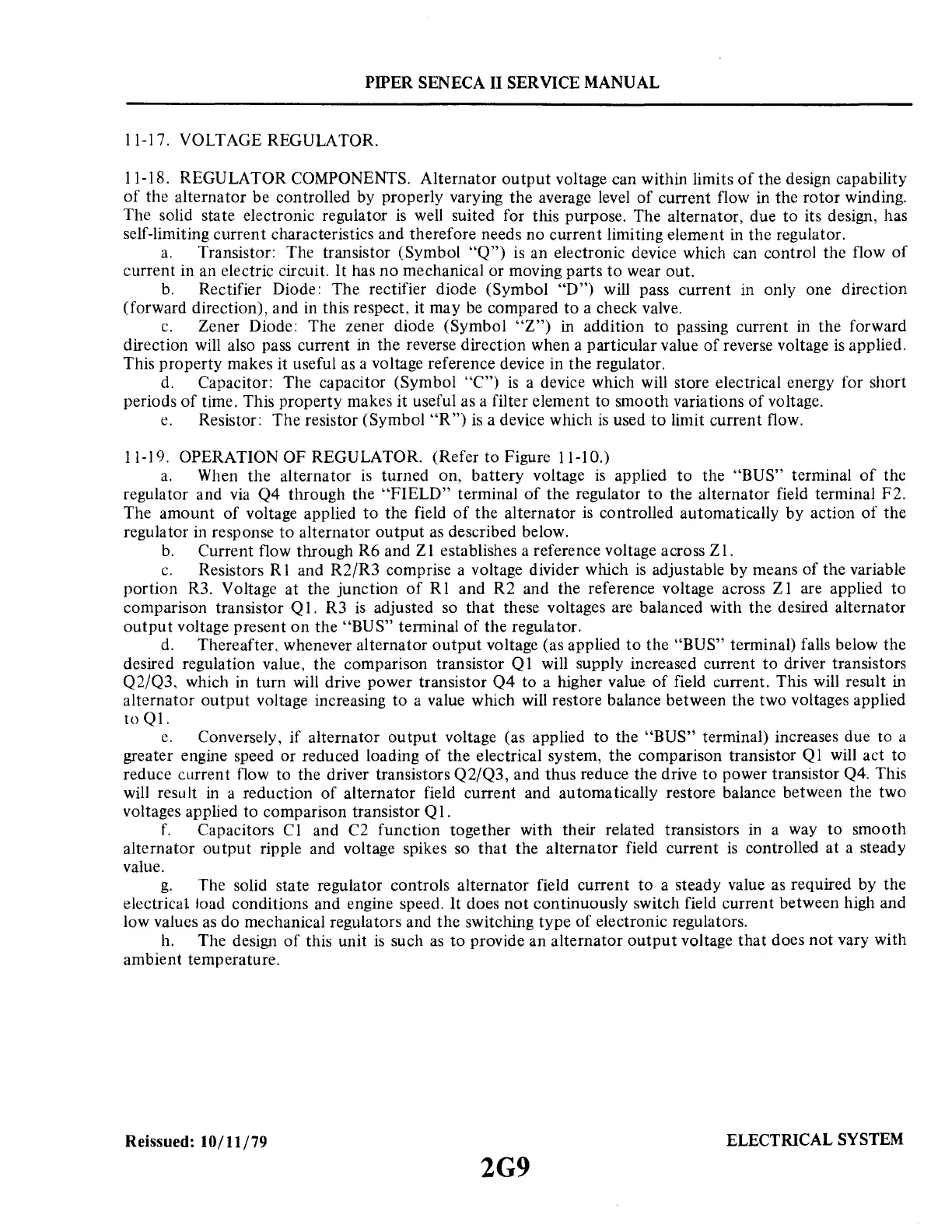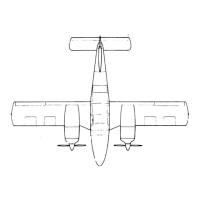PIPER
SENECA
II
SERVICE
MANUAL
11-17. VOLTAGE REGULATOR.
11-18. REGULATOR COMPONENTS. Alternator
output
voltage can within limits
of
the design capability
of
the alternator be controlled by properly varying the average level
of
current flow in the
rotor
winding.
The solid state electronic regulator
is
well suited for this purpose. The alternator, due to its design, has
self-limiting current characteristics and therefore needs no current limiting element in the regulator.
a.
Transistor: The transistor (Symbol
"Q")
is an electronic device which can control the flow
of
current in an electric circuit. It has
no
mechanical or moving parts
to
wear out.
b. Rectifier Diode: The rectifier diode (Symbol
"D")
will pass current in only one direction
(forward direction), and
in
this respect, it may be compared to a check valve.
c.
Zener Diode: The zener diode (Symbol
"Z")
in addition to passing current in the forward
direction will also pass current in the reverse direction when a particular value
of
reverse voltage
is
applied.
This property makes it useful as a voltage reference device in the regulator.
d. Capacitor: The capacitor (Symbol
"C")
is
a device which will store electrical energy for short
periods
of
time. This property makes it useful as a filter element to smooth variations
of
voltage.
e.
Resistor: The resistor (Symbol
"R")
is
a device which
is
used
to
limit current flow.
11-19.
OPERATIONOFREGULATOR.
(RefertoFigure
11-10.)
a.
When the alternator
is
turned on, battery voltage
is
applied to the "BUS" terminal
of
the
regulator and
via
Q4 through the
"FIELD"
terminal
of
the regulator to the alternator field terminal F2.
The amount
of
voltage applied to the field
of
the alternator
is
controlled automatically
by
action
of
the
regulator in response to alternator
output
as
described below.
b.
Current flow through R6 and Z 1 establishes a reference voltage across Z
1.
c.
Resistors R 1 and
R2/R3
comprise a voltage divider which
is
adjustable by means
of
the variable
portion R3. Voltage at the junction
of
R 1 and R2 and the reference voltage across Z I are applied to
comparison transistor
QI.
R3
is
adjusted so
that
these voltages are balanced with the desired alternator
output
voltage present
on
the
"BUS"
terminal
of
the regulator.
d. Thereafter, whenever alternator
output
voltage (as applied
to
the "BUS" terminal) falls below the
desired regulation value, the comparison transistor Q 1 will supply increased current to driver transistors
Q2/Q3, which in turn will drive power transistor
Q4
to a higher value
of
field current. This will result in
alternator
output
voltage increasing to a value which will restore balance between the two voltages applied
to
QI.
e.
Conversely, if alternator
output
voltage (as applied to the
"BUS"
terminal) increases due to a
greater engine speed
or
reduced loading
of
the electrical system, the comparison transistor QI will act to
reduce current flow to the driver transistors Q2/Q3, and thus reduce the drive
to
power transistor Q4. This
will result
in
a reduction
of
alternator field current and automatically restore balance between the two
voltages applied to comparison transistor Q
1.
f.
Capacitors CI and C2 function together with their related transistors in a way
to
smooth
alternator
output
ripple and voltage spikes so
that
the alternator field current
is
controlled at a steady
value.
g.
The solid state regulator controls alternator field current to a steady value as required by the
electrical load conditions and engine speed. It does
not
continuously switch field current between high and
low values
as
do
mechanical regulators and the switching type
of
electronic regulators.
h. The design
of
this unit
is
such
as
to provide an alternator
output
voltage
that
does
not
vary with
ambient temperature.
Reissued:
10/11/79
ELECTRICAL
SYSTEM
2G9

